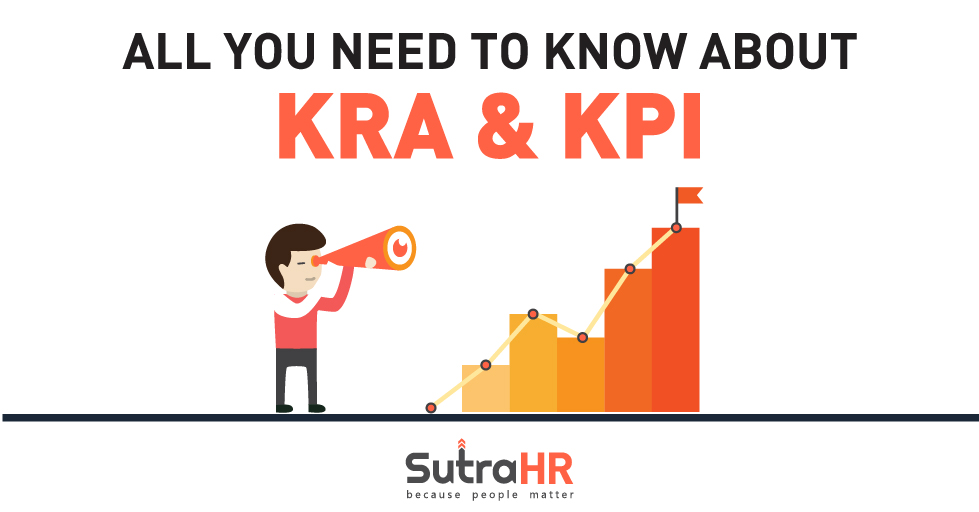What is KRA and KPI? What’s the difference between them?
KRA, Key Responsibility Areas, weren’t established until the 1900s. After Elton Mayo measured the relationship between productivity and the work environment in 1920, the government also contributed to improving employee satisfaction in 1950. The Performance Rating Act and Incentive Awards Act were introduced by them. Aubrey Daniels was the one to coin the term ‘performance management’ a couple of decades after that. After a series of evolutionary steps, performance management finally came online in the 2000s.
Performance management can get complicated. The listed of things needs to be kept in mind while reviewing an employee’s performance and providing feedback. For this reason, KRAs and KPIs are designed for every employee to measure their performance formally. Here’s what you need to know about what KRA and KPI are and how to write KRAs and KPIs, along with their example and Benefits.
What is KRA?
Key Responsibility Areas are based on the job description of a person and are used when assigning tasks that they are expected to perform. Employees are solely responsible for the specific KRAs assigned to them. KRAs are a larger goal. For example, as a content writer, your KRA would be to produce content that performs and ranks well.
What is a KPI?
Key Performance Indicators are a subset of KRAs. We would measure a person’s performance based on the results they achieve. KPIs can be exactly measured. Following up on the previous example, a content writer’s KPI would be when a particular feature or article about their company ranks in the top 3 search results. If you offer coworking spaces, your KPI would be your space showing up in the top 3 results for something like coworking spaces in Mumbai.
How to write KRAs?
While writing a KRA, here are some things to keep in mind:
- Since these are based on job descriptions, go through the JD of the employee thoroughly. Discuss with their manager and them if need be.
- Clearly define what the employee should achieve and how they will contribute to the organization’s progress.
- Record all critical responsibilities that need to be performed on the job, including tasks that can be measured in numbers, percentages, and other quantifiable terms.
- Set goals based on these responsibilities, and write self-explanatory descriptions of every goal.
- Ensure you set measurable and realistic targets and timeframes when describing these goals
How to write KPIs?
While writing a KPI, here are some things to keep in mind:
- As mentioned previously, KPIs are subsets of KRAs. Once you have a KRA in place, you can get a definitive and measurable KPI.
- Suppose you had a KRA of buying in the 1cr worth of revenue in a year.
- To achieve this, your KPI could be bringing in revenue through 60% of new business, 30% renewals, and 10% via other methods.
- After having a large goal, smaller goals to contributed to the achievement of the larger goal will be your KPI. Thus, your KPI depends on your KRA.
Timely reviews can help in improving an employee’s performance. The shorter the period between reviews, the better it is. Performance reviews and generally conducted on a monthly, quarterly, half-yearly, or annual basis, based on the company policy. Keeping track of every employee’s review cycle can be tricky. Managing these via email and setting reminders is time-consuming and can result in complications.
To solve this issue and make performance reviews easier, performance management systems were introduced. With a performance management system, you can automate the entire process. The organization can customize and create review cycles according to its policies and requirements. These systems also provide you with feedback forms and generate reports and graphical analysis of the review.
The Following are KRA Examples & Benefits for all Management:
1. KRA helps state things very clearly, such as what to do and how to go after it.
2. We measure performance based on this.
3. With the help of KRA, it becomes effortless to align with the Job Role and Working environment.
4. KRA helps to set a realistic time-bound based on the Organization’s business plans.
5. It helps to look into critical roles and responsibilities in various sections of the Organization.
6. Gives fair performance reviews of the Employee’s work.
7. KRA helps to get the right employee who can fulfill the organization’s needs.
The Following are KPI Examples & Benefits for all Management:
1. KPI allows the manager as well as the Organization to measure and manage the target and goals
2. Keeping the right set of people within the Organization who cope with the business KPI performance.
3. Intuitive records of performing against the Goal of the Organization.
4. KPI helps the metrics visible to everyone, such as who is performing better and who is not at all performing.
5. When an employee comes to know that he is been measured, his behavior automatically improves towards the Performance.
6. This Improves the decision-making skills that are entirely based on the data available through KPI.
7. Provides a complete overview of the Progress in regards to the Goal of the Organisation.
Final Thought of What is KRA & KPI
Key responsibility areas (KRAs) and key performance indicators (KPIs) are essential for cultivating a performance-focused environment in any company. KRAs outline what employees are accountable for in their positions, while KPIs assess how effectively they accomplish those tasks. Combined, they establish clarity, purpose, and responsibility – vital components for individual advancement and organizational achievement. Grasping and utilizing KRAs and KPIs not only ensures employees work in line with business targets but also helps them monitor their progress and concentrate on results. For managers and HR, these tools present a structured method to assess performance, identify areas needing improvement, and give constructive feedback. Properly implemented, KRAs and KPIs contribute to higher productivity, better goal alignment, and a more engaged team. In today’s fast-paced business world, mastering these concepts is vital to maintain a competitive edge and build a high-performing team.
Frequently Asked Questions of KRA and KPI
1. What is basic KRA?
Key Result Areas (KRAs) are specific, critical areas where an individual or organization must achieve results to meet their objectives. They focus on key tasks and responsibilities, aligning with overall goals. KRAs help in setting clear expectations, monitoring performance, and ensuring accountability, making them essential for effective performance management.
2. What is the Difference between KRA and KPI?
- KRA (Key Result Area) defines the specific goals and responsibilities of an individual or team, focusing on what needs to be achieved.
- KPI (Key Performance Indicator) measures the effectiveness and success in meeting those goals, providing quantifiable data on performance.
3. What are KRA and KPI Examples?
KRA (Key Result Areas) and KPI (Key Performance Indicators) are vital for tracking performance. Suppose you are a recruitment agency.
- KRA: Sourcing quality candidates, client satisfaction, and timely placement.
- KPI: Number of candidates placed per month, client feedback scores, and time-to-fill positions.
These metrics help track and enhance performance in meeting client needs and recruitment goals.
4. What is KRA and KPI for Employees?
- KRA (Key Result Areas) are specific outcomes or goals that employees are expected to achieve in their roles.
- KPI (Key Performance Indicators) are measurable values used to assess how effectively an employee is meeting their KRAs.
While KRAs outline what needs to be accomplished, KPIs provide metrics to track performance and progress toward those objectives.
5. What is KRA and KPI Full Form?
- KRA stands for Key Result Area, focusing on key responsibilities.
- KPI stands for Key Performance Indicator, measuring success in achieving goals.









